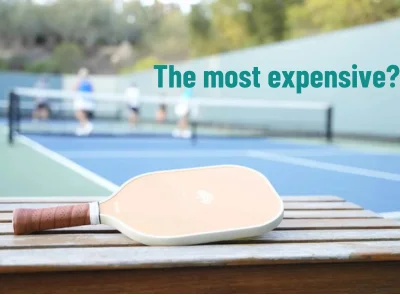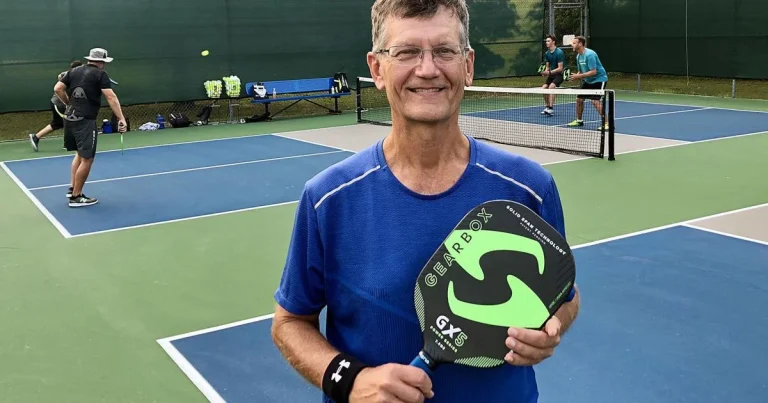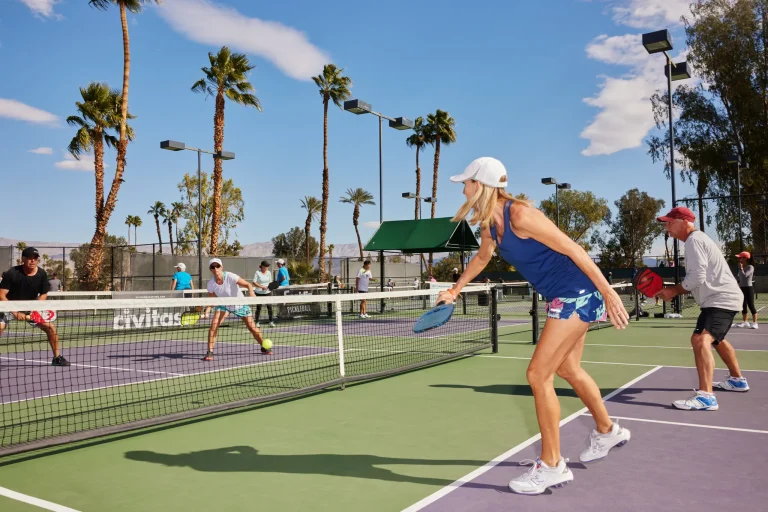Pickleball is gaining popularity and attracting many players of all ages. A pickleball ball is not only a piece of equipment, but it also plays a pivotal role in determining the game’s pace, control, and whole dynamics. Regardless of where you play, the ball you use greatly impacts your performance and abilities on the court.
Each ball has distinct characteristics, including size, weight, and substance, that are customized to varied playing settings, such as indoor courts, outdoor surfaces, or even training sessions. This article will go over the important components of pickleball balls, from basic specifications to the best selections for different skill levels. That way, you may improve your experience on the court by making well-informed selections.
Pickleball Ball Specifications
In the early days of pickleball, players used modified balls. This ball was created by poking holes through a perforated plastic ball. Yet as the game’s popularity grew, so did the need for a pickleball-specific ball. Thus, manufacturers began creating balls with standardized hole patterns and sizes to ensure consistency in play.
A modern-day pickleball ball is a lightweight, perforated plastic ball created only for this sport. It resembles a Wiffle ball but is slightly smaller and more sturdy. These balls are designed specifically for the game, with holes to reduce wind resistance and provide a consistent flight. The ball’s size, weight, and colors not only influence the ball’s performance on the court but also affect players’ experience.
What Is The Size Of Pickleball Ball?
The standard size for a pickleball ball is between 2.87 to 2.97 inches in diameter. This size range is carefully crafted to balance ease of handling, flight stability, and paddle interaction. The size affects its flight path and the precision of shots, ensuring a consistent experience when you play. Balls that deviate from this size range may not perform optimally or meet official tournament standards.
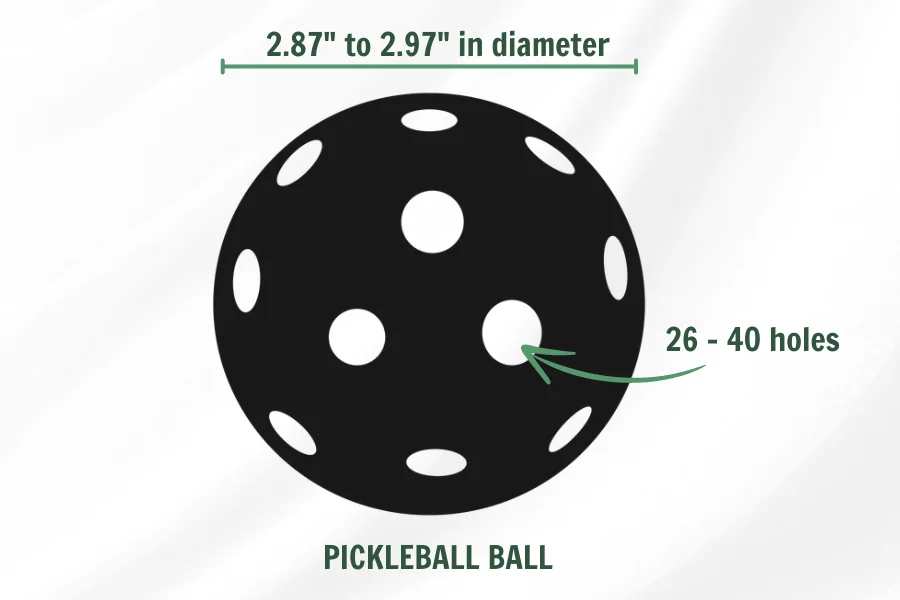
How Much Does A Pickleball Ball Weight?
The standard weight of a pickleball ball runs from 0.78 to 0.935 ounces. The weight of the ball affects its performance characteristics. It also offers the proper balance between control, power, and durability.
- The lighter ball will be extra responsive, producing speedier shots and easier control.
- A heavier ball is more stable and best for use outdoors, where the wind may affect the flight of the ball.
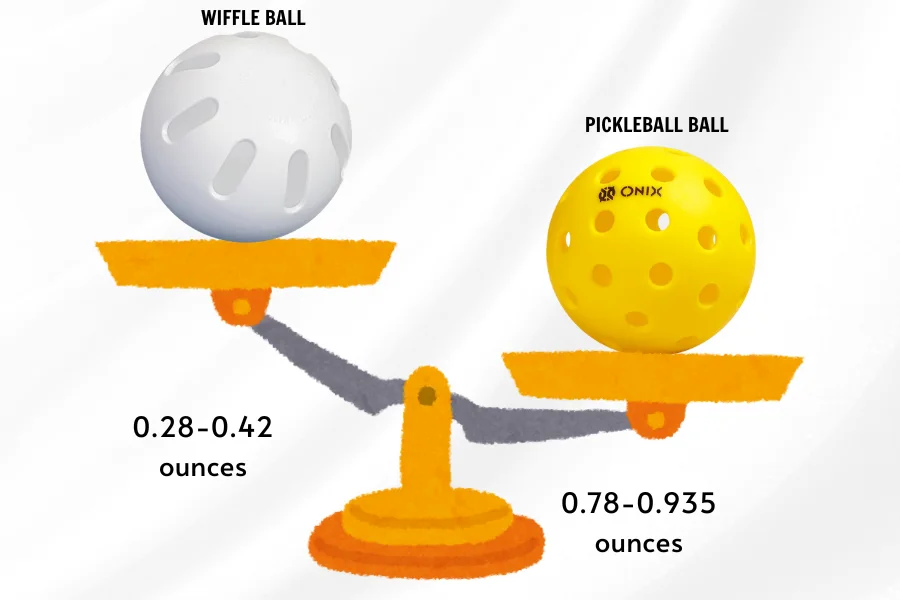
Besides, the shots are also affected by the weight of the ball. Heavy balls require more hitting force and last longer. Yet they have a large momentum when the ball is in motion.
What Is The Regulation Color Of Pickleball Balls?
The color of a pickleball ball is not simply for cosmetic impressions. Instead, it adds better visibility against all kinds of backgrounds. Pickleball balls are available in many colors, most commonly yellow, neon green, and orange.
For instance, a bright yellow or green color would be preferable with an indoor court’s controlled lighting. Conversely, an orange ball may be preferred to be played outdoors since it brings out better contrasts with most natural surroundings. This choice may dramatically affect a player’s ability to track the ball during fast-paced rallies. So, this becomes an important factor in which ball to choose while playing under certain conditions.
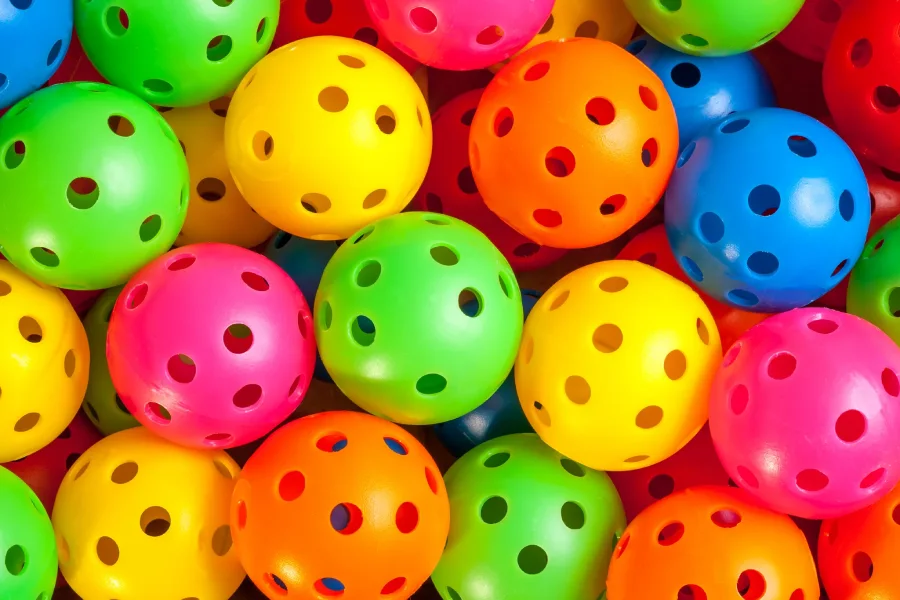
What Is A Pickleball Ball Made Of?
Pickleball balls are crafted from different materials depending on their intended use. A pickleball ball is typically made from either plastic or foam. Each material offers unique characteristics suited for different playing environments and purposes.
The majority of pickleball balls are constructed from durable, lightweight plastic, impact-resistant plastic. Harder plastic balls can withstand many weather conditions and rough surfaces, providing a consistent bounce and greater durability. On the other hand, softer plastic balls offer a lower bounce and more controlled play.
In addition to plastic balls, foam balls are also used in pickleball, particularly for beginners or indoor training. These balls are softer and lighter, which helps players develop their skills without the intensity of regular play. Foam balls are also quieter and less likely to cause damage, making them suitable for indoor practice sessions or for players starting to learn the game.
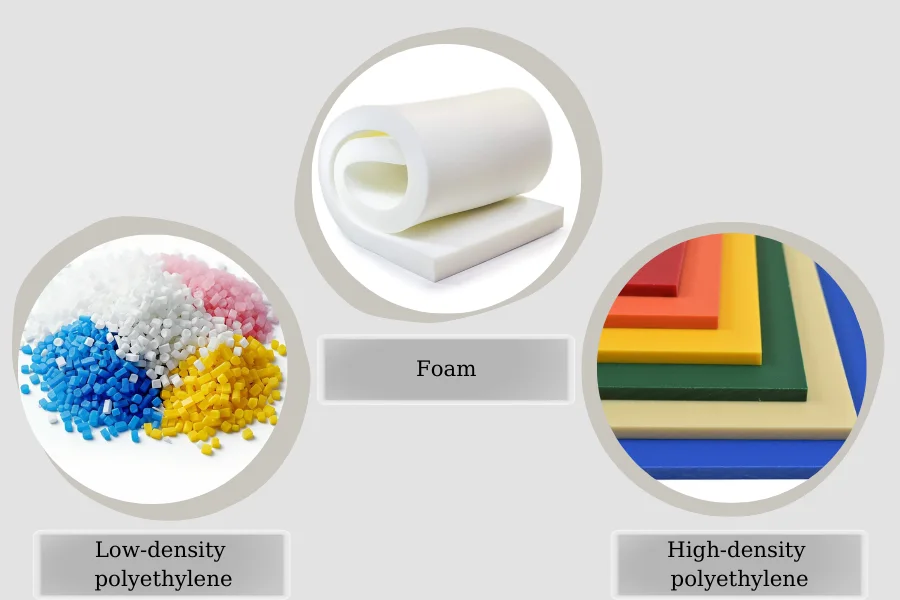
3 Types of Pickleball Balls
Pickleball balls are made especially to fit a variety of playing conditions and environments. There are two primary categories of pickleball balls: indoor vs. outdoor balls. But recently another special type of ball has appeared on the market – foam balls. Every variety has unique advantages and characteristics that fit various playing styles and environments.
#1. Indoor Balls
Indoor pickleball balls are made specifically for indoor courts and are not affected by environmental conditions. Their average dimensions are 2.8 inches in diameter and 0.8 to 0.9 ounces in weight.
These balls are made of softer plastic, such as low-density polypropylene (LDPE), which provides a lower bounce and softer feel when hit. With 26 big holes, these balls have a lower bounce and speed, allowing for more controlled and precise movement.
Indoor balls have vibrant colors, prevalent in bright colors like yellow, orange, or green. These colors will ensure visibility against various indoor backgrounds. But because of their softer construction, they often don’t last as long as outside balls.
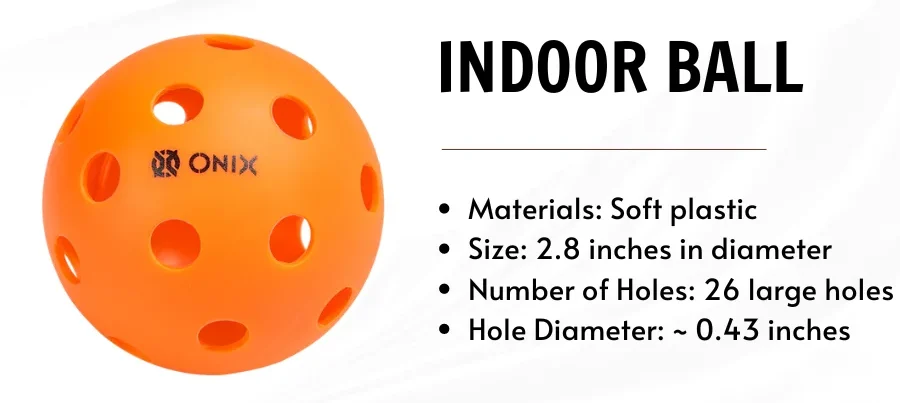
- Excellent control for precise shots
- Softer feel, reducing strain on players’ arms
- Better visibility due to bright colors
- Less durable, prone to cracking when playing on hard surfaces
- Reduced speed compared to outdoor balls
- A lower bounce might cause difficulty for some players
Impact on Gameplay
Due to their softer feel and lower bounce, indoor balls allow focus more on precision and control rather than power and speed. The huge holes add to the ball’s slower flight. This provides more time for players to position themselves and react to their opponent’s shots.
Furthermore, indoor balls are quieter, which is helpful in noise-sensitive settings. Yet a low volume could lessen the audible feedback that certain players rely on to determine the success of a shot.
#2. Outdoor Balls
Outdoor pickleball balls are intended to survive the tougher conditions of an outdoor court (rougher surfaces or wind). They are slightly larger than indoor balls, with a diameter equal to 2.9 inches. These balls are constructed of harder, more durable plastic, such as high-density polyethylene (HDPE or PP).
With forty tiny holes, outdoor balls are more stable in flight by reducing the effect of wind. These balls tend to be available in vibrant colors such as neon yellow or orange. Their visibility is improved by these hues under different outdoor lighting settings.
Both the bounce and sound of these balls when struck are higher. These balls tend to wear out sooner and can need more replacements because of the harsher playing conditions outside.
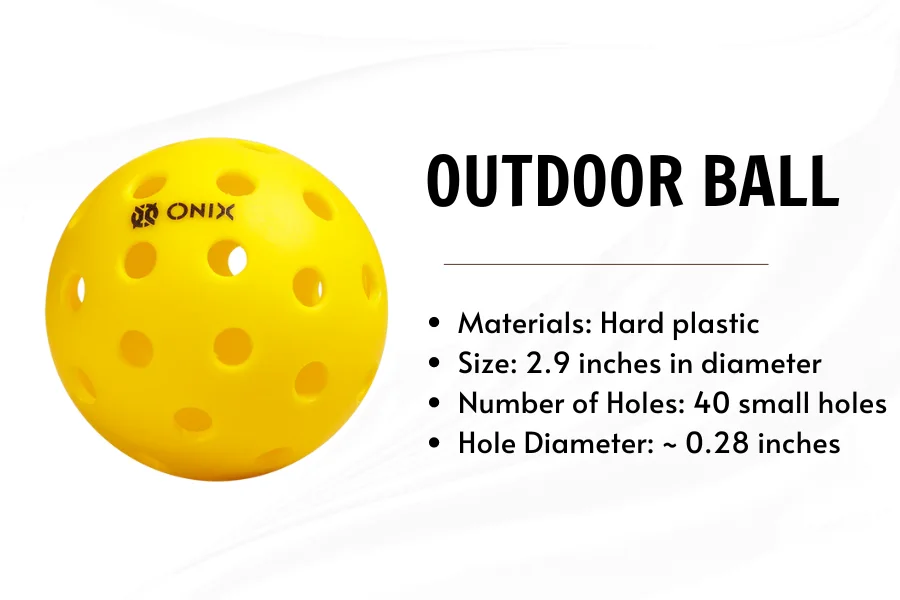
- Durable and resistant to outdoor conditions
- Stable flight in windy conditions due to smaller holes
- Higher bounce, offering faster gameplay
- Less control and precision compared to indoor balls
- Louder sound, which can be disruptive in quiet areas
- Can crack or wear out quickly due to rough surfaces
Impact on Gameplay
The stronger structure and higher bounce of outdoor balls will increase the game’s speed and power. The smaller holes ensure that the ball’s flight is less impacted by wind, resulting in more consistent and predictable play. Yet the tougher material and faster pace can make it more difficult for players to control the ball. The stronger impact of outdoor balls might contribute to faster weariness or discomfort when during prolonged play.
What Are The Differences Between Indoor And Outdoor Ball?
Because these types of balls look so similar, it appears hard for non-professionals to differentiate them apart. Yet comparing them side by side reveals that they differ greatly in some aspects.
| Key Factor | Indoor Pickleball Ball | Outdoor Pickleball Ball |
|---|---|---|
| Material & Durability | An indoor ball is typically made from low-density plastic. It is durable enough for indoor play, yet is less resistant to wear and tear when used on rough surfaces. | An outdoor ball is made from harder, more durable plastic. It lasts longer on rough outdoor surfaces and in varying weather conditions. |
| Number of Holes | Indoor balls have larger and fewer holes, usually around 26, which helps create a more controlled and slower flight path. | Outdoor balls feature more holes, typically 40 smaller holes, which provide better wind resistance and more stable flight patterns in outdoor conditions. |
| Bounce | Indoor balls have a lower bounce. | Outdoor balls offer a higher, more consistent bounce. |
| Sound | Indoor balls produce a quieter sound upon impact, which is more suitable for play where noise levels may need to be kept down. | Outdoor balls tend to be louder due to the harder material, which can be a consideration depending on where you play. |
| Performance & Weight | Indoor balls are generally lighter and provide better control and touch. | Outdoor balls are heavier and offer more power and speed. They perform well in outdoor conditions, including wind resistance. |
Read more: Indoor vs Outdoor Pickleball
#3. Foam Balls
Compared with traditional balls, the foam balls are light and soft. They are made from soft and lightweight foams, usually known as quiet pickleball balls. The foam balls are rather huge with a diameter of 3 inches compared to the standard diameter of the pickleball balls.
A foam ball has no holes and is a solid sphere with bold, brilliant colors. Because of its soft nature, foam balls are less durable and may need to be changed more than usual, especially when used on hard surfaces. These balls are not often used for competitive play because of their lower speed. Instead, they often serve for practice drills and skill improvement, requiring noise reduction.
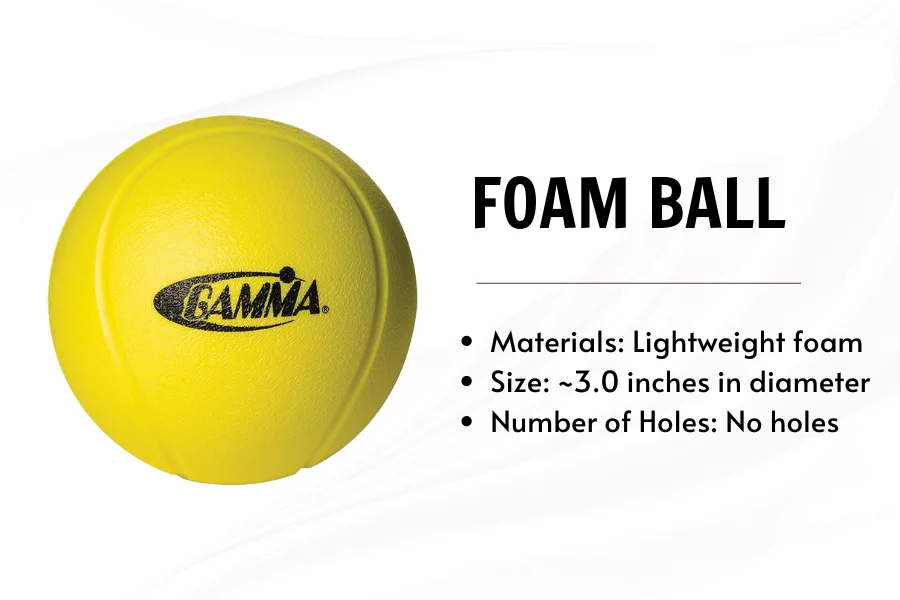
- Soft and lightweight
- Quiet play, ideal for indoor settings
- Lower risk of injury or damage, safer for beginners and children
- Less durable than regular pickleball balls
- Lower bounce and slower speed
- Not suitable for competitive play
Impact on Gameplay
Foam balls enable a softer, less aggressive game. They are a lot slower and more forgiving than plastic balls. The softer impact of foam balls helps reduce the risk of injury. As a result, foam balls are an ideal choice for practice sessions and recreational sports. They allow players to focus on improving their skills and techniques rather than worrying about fast-paced shots.
Foam balls are not appropriate for competitive play or outdoor activities. Their lightweight design makes them prone to wind interference, and their softer texture results in less precise shots and lower bounce. When using foam balls, players will notice a slower game speed and less responsiveness.
Top Pickleball Ball Brand
The brand of pickleball balls you can choose will indeed make a great difference in the way you play. Here we have a look at some top-selling brands that you can opt for.
Brands for Indoor Play
The top brands for playing on indoor courts are Jugs, Gamma, and Onix Fuse. These are softer pickleballs with bigger holes. This brand usually offers balls that are designed with a softer bounce, softer impact, and a good range of control on hard indoor surfaces.
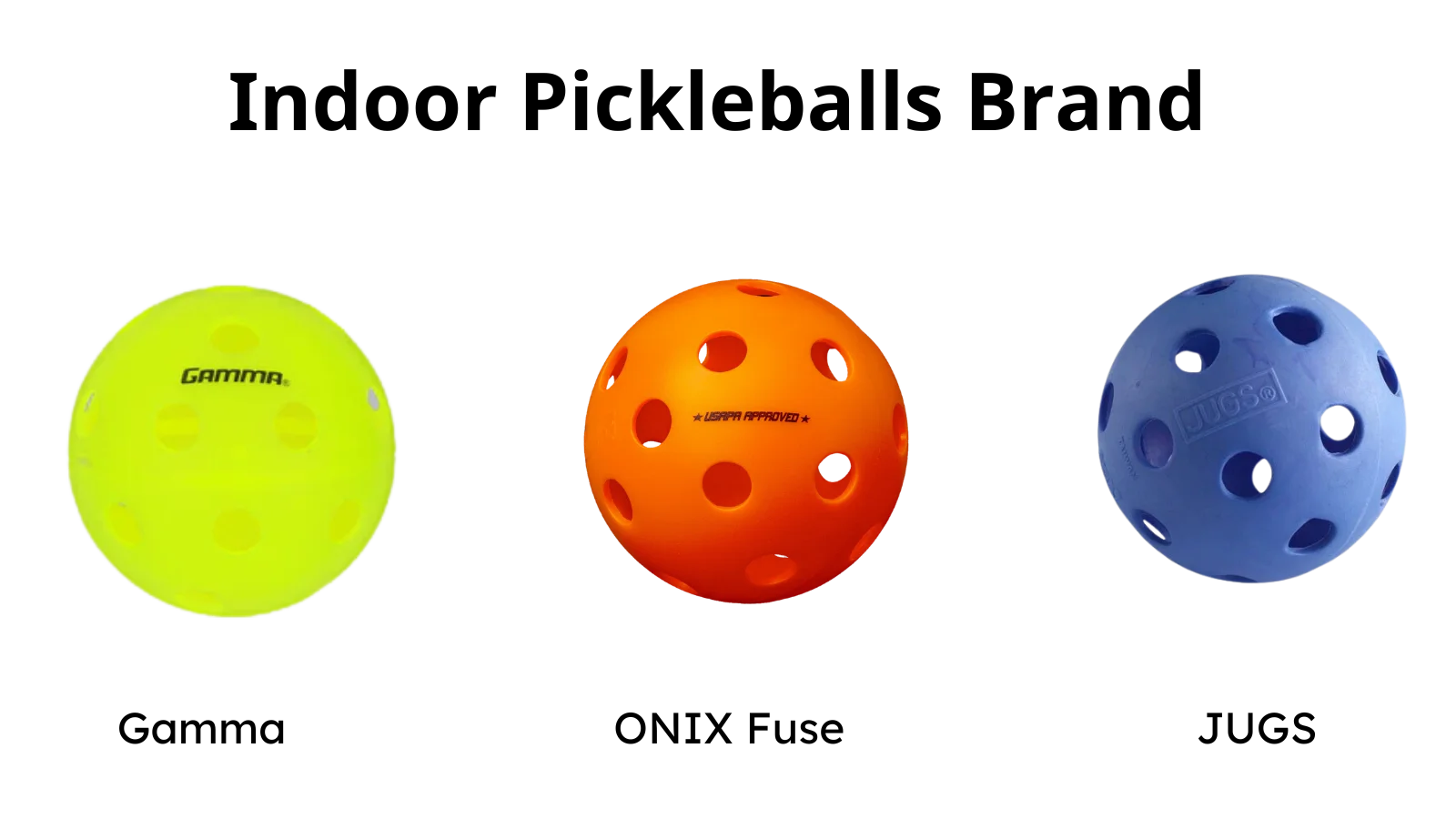
Brands for Outdoor Play
When it comes to outdoor pickleball, brands such as CORE, Engage, and Penn dominate the market. These brands produce balls with smaller holes and harder plastic, ensuring durability and stability in various weather conditions. They are very durable with reliable and consistent bounce.
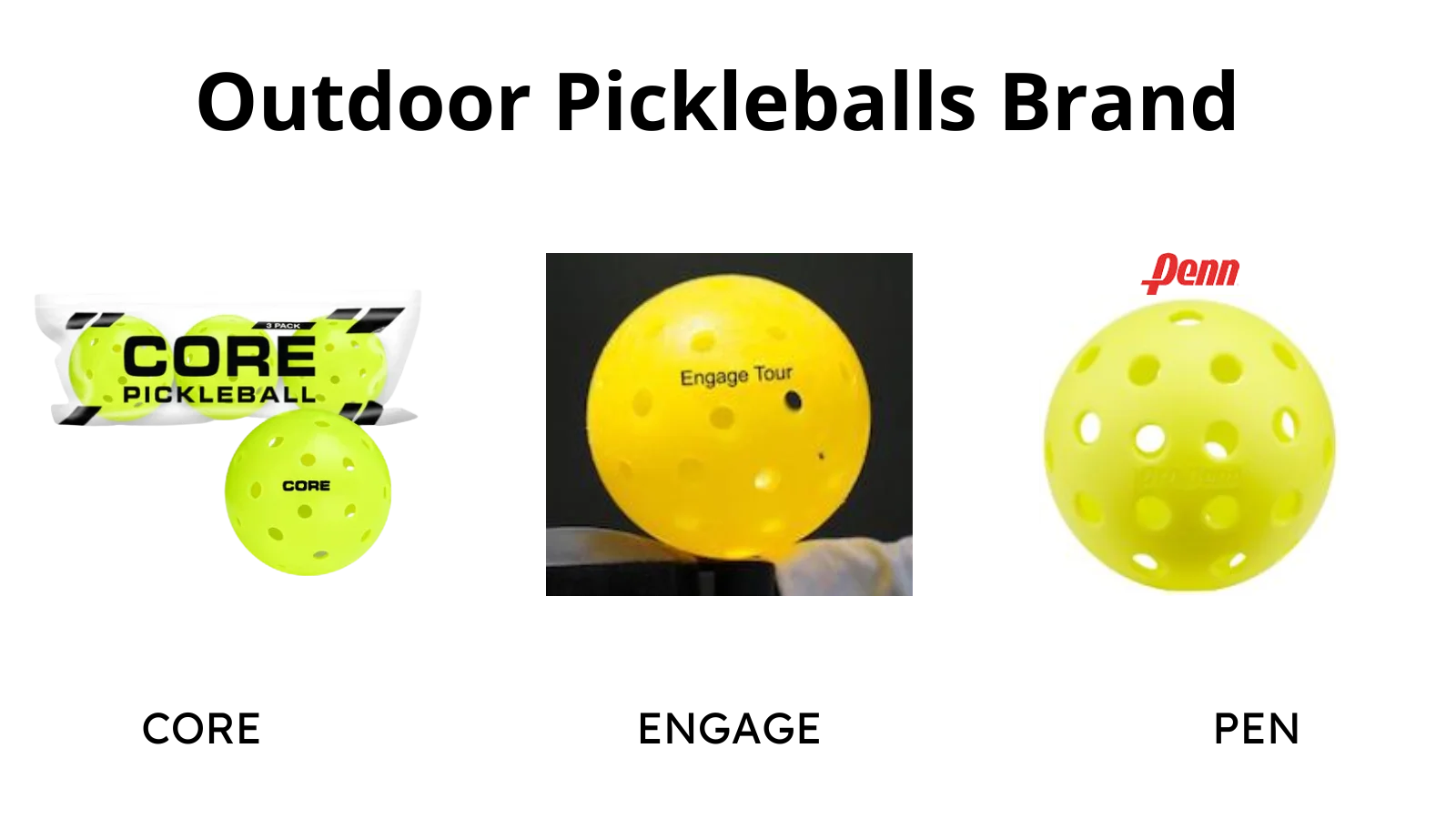
Best Brands for Tournament Play
For those looking to compete at higher levels, brands like Onix Dura, Vulcan, and Franklin are highly recommended. These brands manufacture that meet official tournament regulations. They also are favored by professional players for their precision, durability, and general performance in competitive settings.
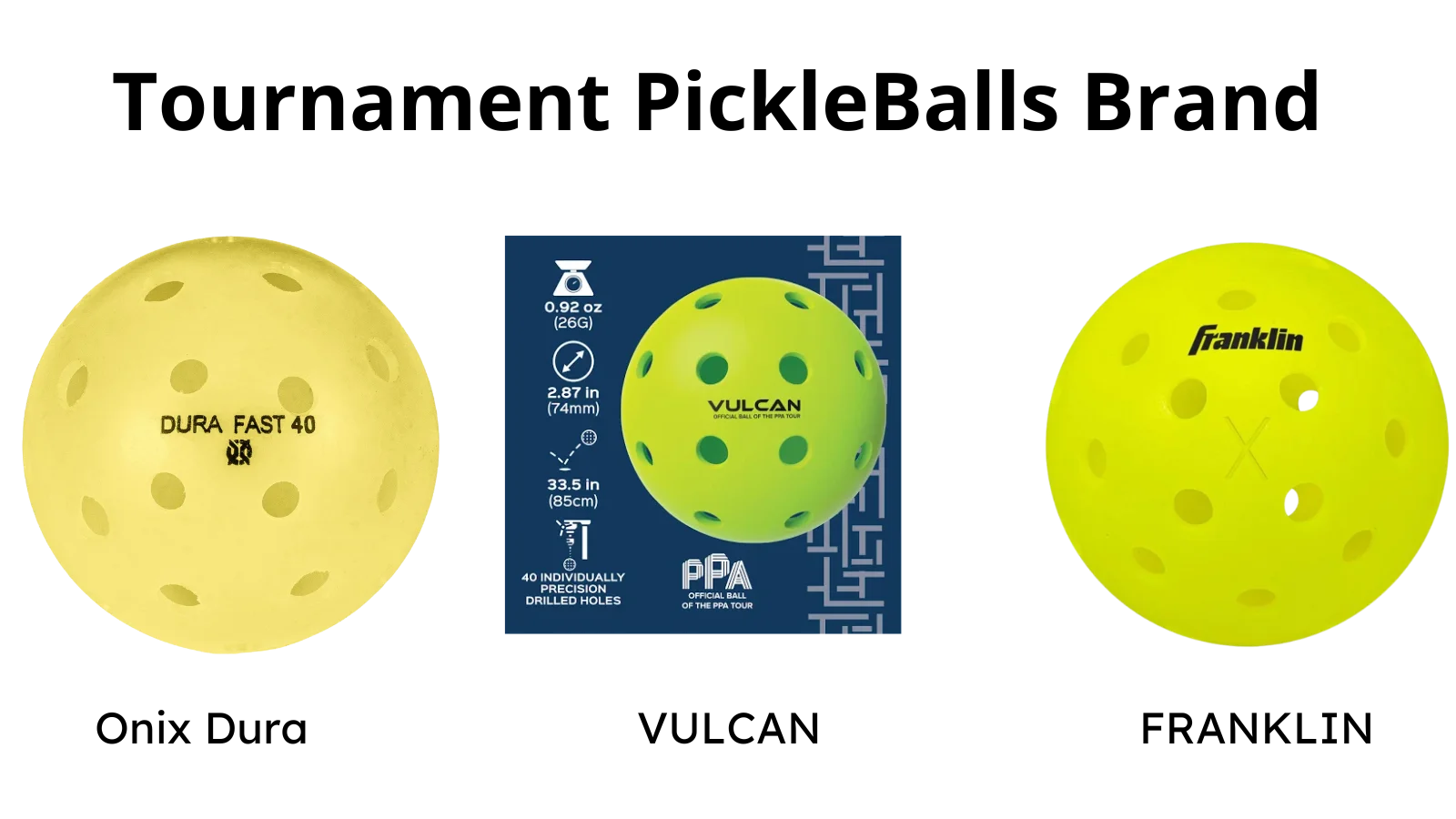
Pro players in pickleball often use high-quality, durable balls for consistent performance in tournaments. The most commonly used balls include the Onix Dura Fast 40, Franklin X-40, and Vulcan VPRO FLIGHT, all known for their superior construction and stability.
These balls are approved by organizations like the USA Pickleball Association (USAPA) and the Professional Pickleball Association (PPA).
Pickleball Ball Regulations
In pickleball, adherence to specific ball regulations ensures fair play and consistency across the sport. The regulations set by governing bodies like the USA Pickleball Association (USAPA) cover various aspects of pickleball balls:
| Key Factor | USA Pickleballs Regulations |
|---|---|
| Size | Pickleball balls must have a diameter of 2.87 to 2.97 inches with a maximum deviation of 0.02 inches. |
| Weight | The balls should weigh between 0.78 to 0.935 ounces. This weight range gives the ball the right balance of durability and flight characteristics. |
| Material | Pickleball balls are typically made from durable plastic, which can withstand frequent play and various weather conditions. The plastic is often molded into a seamless, one-piece design or made with a two-piece construction to enhance durability. |
| Design | The ball must have between 26 and 40 circular holes. The hole spacing and the ball’s general shape adhere to flight characteristics. The manufacturer’s or supplier’s name or logo has to be stamped or embossed on the ball’s surface, along with the “USA Pickleball Approved” seal or text treatment on the ball package. |
| Bounce | Regulations specify that the ball must bounce consistently on different surfaces, typically achieving a bounce height of 30 to 34 inches when dropped from a height of 78 inches onto a granite surface plate. The test is to be performed at an ambient temperature of 70 ± 5 degrees F. |
| Color | Except for identification markers, the ball will have a single consistent color. Yet they are generally available in bright colors such as neon yellow, green, or orange. The choice of color can vary based on personal preference and visibility in different lighting conditions. |
How To Choose A Pickleball Ball?
When choosing a pickleball ball, remember this key takeaway – which is based on my experience playing on the court:
- Indoor ball for indoor courts, outdoor ball for outdoor courts. – Indoor balls are designed for smoother surfaces, while outdoor balls are built to withstand rougher, outdoor conditions.
- If you rank durability and long-term use, choose outdoor balls. Their tougher construction makes them more resilient and longer-lasting, especially on abrasive outdoor surfaces.
- For a ball that works both indoors and outdoors, choose versatile outdoor balls that offer a balance of control and durability. Though mainly for outdoor use, their combined performance suits various environments.
In Summary
Whether you play in a professional league or recreational exercise, the choice of the appropriate pickleball ball determines the improvement of the game. Each kinds provide unique benefits, which will suit various playing conditions. The type of ball that is going to be used in the game (indoor, outdoor, or for training) will significantly affect the performance of the players on the court.
- Indoor balls are less bouncy and can be used for indoor play only
- Outdoor balls are more solid in different weather.
- The foam balls are recommended for beginners and practice sessions since they are slightly softer and have a less buoyant bounce.
A perfect ball will fit your performance criteria while also reflecting your unique taste and style. It is also possible to try several brands and types of balls at once. All in all, it is crucial to understand that choosing the correct pickleball ball is more about finding the optimal combination of measurements and your particular conditions on the court. Through there, this makes it an important aspect that should not be missed out on your strategy.


